The most dangerous and poisonous animals on planet Earth are deadly to other creatures as well as human beings. Almost 400 species are dangerous to humans and most of them found everywhere except some of the rare venomous animals. Thousands of people receive venomous bites every year across the globe and hundreds of people die. Australia alone has large number of venomous snakes than any other country in the world and one of the deadliest and killer snake is also found in Australia, its one bite can kill over 100,000 mice.
The top most venomous animals are found on different parts of the planet and have very devastating venom than other species. The top position is still hold by the king of venom ‘snake’. So, lets have a look at top 10 venomous animals in the list of most venomous animals.
SEE ALSO: 21 Amazing and Scary River Monsters
Taipan Snake
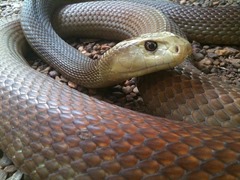 One of the most dangerous and killer snake found in Australia is the Taipan. It’s a fast and highly poisonous snake found on the planet. The bite of Taipan is 100 times deadly than an American diamondback rattlesnake. The Taipan grows to be two meters long and has longest fangs of any other Australian snake.
One of the most dangerous and killer snake found in Australia is the Taipan. It’s a fast and highly poisonous snake found on the planet. The bite of Taipan is 100 times deadly than an American diamondback rattlesnake. The Taipan grows to be two meters long and has longest fangs of any other Australian snake.
In toxicity, single bite of Taipan can kill over 100,000 mice or 100 men. The juvenile taipan is as deadly as adults and modified its venom as they grow bigger.
Its toxic poison first paralyses then pre-digest breaking down the muscle tissue even before preys swallowed as whole.
Box Jellyfish
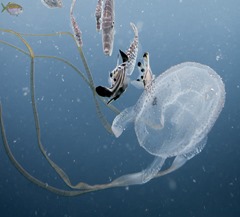 This killer is also from Australia and this deadly Australian killer is from the sea creatures. The main lethal injection of box jellyfish is its tentacles. The box jellyfish has 60 tentacles each of up to three meters long and single tentacles is enough to a kill a human in minutes.
This killer is also from Australia and this deadly Australian killer is from the sea creatures. The main lethal injection of box jellyfish is its tentacles. The box jellyfish has 60 tentacles each of up to three meters long and single tentacles is enough to a kill a human in minutes.
The box jellyfish is almost invisible in water and you never know what hits you. The fastest strike of tentacles blast coiled harpoons deep into your skin with just a touch. The strike is 10 times faster than an air bag inflates the car crash. The hollow harpoons pump venom that target skin, heart and nervous system. It is too painful, shocking, looks and feel like branded with red hot iron.
The venom of a single box jellyfish has enough venom to kill 60 people and is one of the most dangerous sea creatures. The only way to prevent from box jellyfish stinging cells to penetrate the skin is the pantyhose which has to be thick enough to prevent stinging cells penetration into skin.
Blue Ringed Octopus
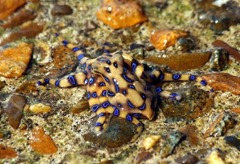 Blue ringed octopus is also a deadly Australian and is one of the venomous sea creatures. This small killer has a lethal bite but it warns before attack by turning its skin into electric blue circles that say back off. This is a warning sign like most of the other animals gives before attack.
Blue ringed octopus is also a deadly Australian and is one of the venomous sea creatures. This small killer has a lethal bite but it warns before attack by turning its skin into electric blue circles that say back off. This is a warning sign like most of the other animals gives before attack.
Octopus venom is effective against any animal with a nervous system and octopus produce neurotoxin saliva from the bacteria. Toxic venom travels quickly to the nervous system and interrupts the chemical transmitters at the junction of nerve cells. The bite effect is bit strange, it turns the human body into living dead by paralysing the muscles we consciously control involuntary muscles and victim become unable to communicate and breathe.
The bite of octopus is so painful and can kill a human in only 90 minutes and is one of the deadly creatures from the sea world.
Centipede
Centipedes are found in vast and different environment conditions and can be found anywhere on the planet. They mostly found in moist areas like rainforests, deserts, under stones, old dead wood.
It’s is a 30 centimetres long, fast, fearless, and brutal killer. The giant centipede can kill bats which is twice the size of centipede and flying fast. It’s a creature kills animals normally larger than its own size and weight like frogs and bats.
It has two fangs under head pump the venom into prey holding into the legs and toxic poison numbs the nervous system and could cause heart attacks to the victim. They can even attack on humans too with their lethal bite.
Wandering Spider
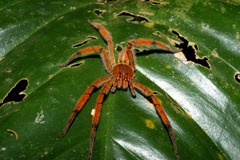 This killer is mostly found in bananas and is one of the killer spiders found on Earth. It is know by the names Brazilian wandering spider, banana spider or armed spider. It has given the name banana spider because it has been found hidden in banana bunches. Some times they arrives with banana shipments to the food stores.
This killer is mostly found in bananas and is one of the killer spiders found on Earth. It is know by the names Brazilian wandering spider, banana spider or armed spider. It has given the name banana spider because it has been found hidden in banana bunches. Some times they arrives with banana shipments to the food stores.
It is probably the world’s most dangerous spider who does not like being disturbed because, it goes offensive after being disturbed unlike other spiders of who run away.
In just few minutes after bite venom starts working and block the transmission of nerve signals of the muscles. The bite is too excruciating and embarrassing and one chemical in venom targets the victim’s private parts and stimulates a painful erection that can last for hours. Without treatment, victim have far bigger problems and a bad bite can cause respiratory failure and death.
Stingray Fish
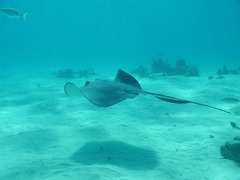 Next creature is also from sea species, stingray fish also know as pussycat of sea. Stingray is a friendly fish but when frightened things go horribly wrong. It mostly attack in self-defence, sometimes when people steps on it or it feel frightened. Stingray is well hidden, most of the time people never know if they are in danger.
Next creature is also from sea species, stingray fish also know as pussycat of sea. Stingray is a friendly fish but when frightened things go horribly wrong. It mostly attack in self-defence, sometimes when people steps on it or it feel frightened. Stingray is well hidden, most of the time people never know if they are in danger.
It has 30 centimetres long tail full of potent poison. The strong muscular tail can drive the spine through the boat or leg or chest and cause instant agony. Although the venom is not so fatal but it hearts a lot.
Stingray venom has some toxins that kill cells and tissues and without treatment wound would become a giant festering ulcer. Stingray venom affects all mammals even the Whales.
Fire Ants
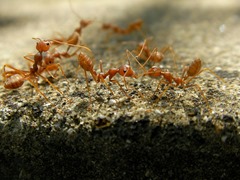 Fire ants, almost found most of the places on planet in groups crawling into the soil. Don’t go on their small size, each year fire ants stings 14 million Americans and at least 100 dies.
Fire ants, almost found most of the places on planet in groups crawling into the soil. Don’t go on their small size, each year fire ants stings 14 million Americans and at least 100 dies.
They’re small in size but their venom is so potent and a single bite feels like a burning match pushed into the skin. Fire ants venom is versatile in different ages and mostly used venom to find food for their colony.
Fire ants will attacks anything that get close to their colony and consists of some of the most potent proteins ever known.
Giant Honeybees
Giant honeybees, attacks in groups when frightened and the nastiest of all bees found ever. It’s an ultimate sacrifice because bee dies after imbedding her hypodermics syringe that continues to pump venom into the wound.
The giant honeybees send warning signs by waving their stings in the air and says back off before attack but some people can’t read the warning signs.
Their sting is a potent weapon in self-defence and even a small dose of venom is so excruciating painful.
Shrew
It’s a small seldom seen and has very bad bite and is the only venomous mammal in North America. Winter is so tough against shrew, they can’t live without venom in winter and is the only life saver for them.
Shrew uses venom to store it’s food by turning zombie worms into living dead and stores underground. Small amount of shrew venom is enough to paralyse that’s why shrew can take on much larger animals and if threatened they will even bite humans.
The poison attacks the nerve cells relaying high speed electrical pulses around the body and block transmission, paralysing prey sometimes more than two weeks.
The shrew venom can kill 200 mice and in humans, cause days of considerable pain.
Komodo Dragon
Three meters long, 150 kilos heavy komodo dragons are the largest lizards on the planet Earth found in Indonesia island where there are more venomous animals per square meter than any other equivalent area on Earth.
Dragon uses venom produced in the salivary glands from the bacteria to kill animals and it is capable of killing tiger with its jaws.
Locals live in fear from komodo dragon and they’re more of a nuisance than a threat for them. They use stones and sticks for protection from komodo dragons.
Photo credit: Charles Strebor, Allen Collins, Nina Matthews, Jonas Söderström, Alex Figueroa, Peter Batty, Marufish, PL Tandon, cotinis, whl.travel

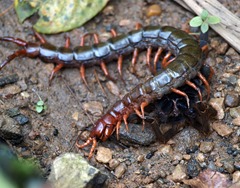
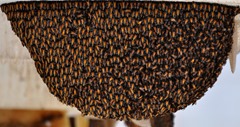
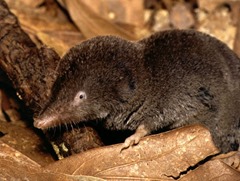
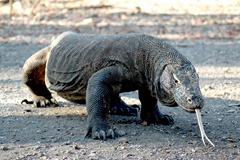
Comments